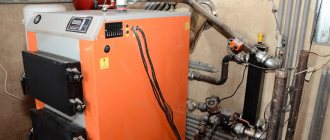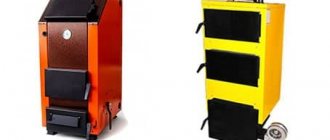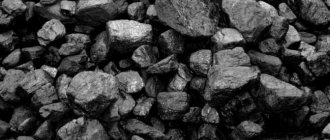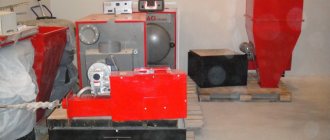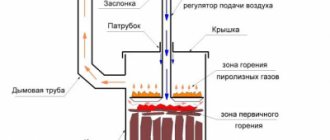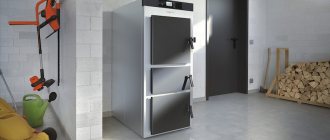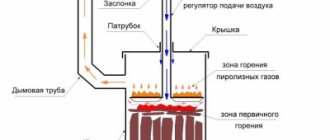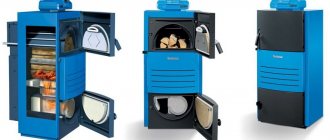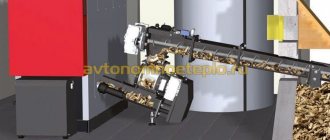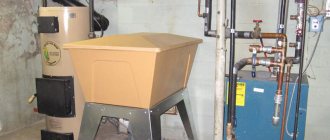A pellet boiler is a solid fuel boiler with automatic fuel discharging.
The main advantage of sawdust boilers is the automatic, dosed supply of fuel from the hopper to the combustion chamber, which allows the user to have a minimum approach to the pellet boiler.
Boilers that use fuel pellets as fuel, when burning fuel, allow the user to fully control the combustion process and adjustments, by adjusting the fuel dosage and supplying the amount of air into the combustion chamber, by adjusting the speed of the blower fan, which in itself is very convenient and practical. The pellet itself will not burn without forced air injection, because... has a high density (620-630 kg of pellets in 1 cubic meter), therefore, when the automatic control of the boiler turns off the air injection fan, it goes from open burning to smoldering mode.
Pellet boilers also have a number of disadvantages when using them.
There are three main disadvantages:
- the high cost of the boiler itself and its installation and proper piping.
- physical costs when procuring pellet fuel for the entire heating season.
- dust in the boiler room from the wood pellets themselves.
All three disadvantages exist and this is a fact, but..
Area of use
Pellet boilers have high technical properties. This explains their widespread use in various fields. Today, experts distinguish between two main areas of application for such heaters:
- Industrial enterprises, restaurants, shops and other institutions and buildings that require heating and hot water supply.
- Such boilers are very popular among owners of country houses. With their help, you can create a productive heating system, the maintenance of which does not require large costs.
Before installing a pellet boiler, you need to familiarize yourself with the different types of boilers and choose the best option for yourself.
Calculation and weight
To calculate the weight of a stack, multiply the number of bearings by a factor, and then check if this number matches the tables that are easy to find on the Internet.
They show the approximate weight of 1 cubic meter of various rocks. For example, fresh oak weighs 1000 kg, but with natural humidity of 15% it weighs only 710 kg.
Example:
Four dry oak logs with a length of 0.25 m and a moisture content of 15% were purchased. Their weight must be checked:
The utilization rate of such wood is 0.76: 0.76*4 = 3.04 cubic meters; 3.04 * 710 kg = 2158.4 kg - this is how much wood you need to buy. If the difference is too big, the seller is trying to deceive.
Please note: when buying a tree, it is important to know not only its volume, but also its weight: If stored improperly, the tree can swell and become much heavier than it was, and the buyer will still have to pay for it.
If the tree was placed in the body of a car, for example, a gazelle or a dump truck, not in a stack of wood, but by throwing it, then the volume of the body must be multiplied by 0.8 by the length of the tree trunk of 0.25 m and 0.75 by the length of 0.5 m. If the tree was placed in the body of a car, then its volume must be increased by 0.8 times. These are average ambient air values for this type of installation.
To calculate the cabinet, see the calculation example in the following video:
Page 3
After building a country house or cottage, everyone thinks about how to heat their home as efficiently as possible. Today there are many types of heaters, and sometimes it is very difficult to choose one or another type of heating.
When designing a heating system, it is strongly recommended to use a heat pump with natural circulation of coolant. In order to understand the essence of the issue, we will describe this type of space heating in more detail, indicate its various characteristics and talk about installing the system.
Operating principle of automatic pellet boilers
When starting the boiler from a cold state, pellets are loaded into the screw fuel supply mechanism manually. After which the automatic control system of the unit starts, the burner lights up and the automatic supply of granules to the combustion area starts.
When the coolant temperature reaches the set value, the flow of pellets stops. When the temperature of the heating water decreases, the supply of pellets in the combustion chamber is restored, followed by automatic ignition of the burner.
Pellet supply
Fuel supply of pellets to the burner is carried out using a conveyor-type screw feeder. Usually it is divided into 2 parts: if the one located closer to the unit runs out of pellets, the second conveyor starts and fills the first with fuel.
The presence of fuel in the feeder is monitored using special photosensors. The fuel supply of pellet boilers is equipped with a pellet storage complex; the volume of the bunker will depend on the thermal power of the installation.

If the built-in pellet bunker is empty, the lower tank sensor will work and send a signal to the safety automatic system, which will turn off the boiler. Many modern pellet burning devices are equipped with an automatic start system.
Boilers can set different fuel supply rates in minutes, that is, the user sets the time for the pellets to reach the combustion level, the default value is no more than two minutes, which is enough for automatic ignition. There is also a vacuum fuel supply speed setting for automatic filling of the fuel hopper.
In the absence of such a system, the automatic intake is controlled by the boiler hose from the external fuel storage.
Ignition and combustion
The pellets are ignited in the same way as any solid fuel. The best option is to use special substances for ignition, although the pellets ignite well even without them. In the case of using liquid kindling, pour it over the granules, wait a little for the liquid to be absorbed, and then set it on fire.
In automatic ignition systems, it is performed by thermal electric heaters through which air is supplied. After the pellets burn well and the flame becomes stable, begin adjusting the air supply to increase the thermal power of the unit.
In cases where it is necessary to increase the duration of fuel combustion and use it more economically, it will be necessary to limit the oxygen supply. In order to increase the combustion rate, air, on the contrary, is added.
Ash removal
In the automated mode, the combustion of granules occurs on the grate of the burner device, the flame is uniform and yellow in color. Then the fuel in the combustion chamber will burn completely, black smoke will not come out of the chimney, and there will be very little ash residue.
Based on the consumer quality of the solid fuel used, ash is removed at different intervals. In this case, it is necessary to ensure that the ash level does not rise to the top of the burner.
Usually the ash is removed before loading the fuel. Modern pellet boilers have an automatic system for cleaning and unloading ash, which prevents the build-up and slagging of internal surfaces around the burner device.
Installation Features
The pellet boiler is installed approximately according to the following scheme. First, the unit itself is installed, after which the burner is connected to it. Then a pellet hopper is installed. Next, connect the auger that supplies fuel. Lastly, the equipment automation is connected.
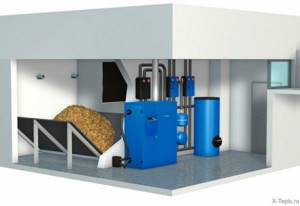
Chimney
During installation, special attention should be paid to the smoke removal system. In order for the chimney duct to provide the necessary draft in any weather conditions, it is necessary to take into account that its diameter must match the size of the outlet pipe. In addition, a condensate drainage device must be built into the chimney.
It is best to use metal pipes for the chimney duct. At the same time, they need to be insulated and the possibility of cleaning the pipes must be provided. Too strong or, conversely, weak draft can damage a pellet boiler, so it is necessary to install a draft stabilizer or a slide valve.
List of the best models of pellet domestic boilers

Despite the great popularity of pellets, the choice of equipment is not so wide:
- Valdai 22M. Russia. This is a single-circuit pellet heating boiler. Power 22 kW is the maximum, 4 kW is the minimum. The equipment runs on peat and wood pellets and can be heated with wood. Raw material humidity up to 35%. When laying firewood, additional grates are installed. Ash content 90%, built-in remote access control unit, overheat protection. Bunker loading up to 160 kg. Consumption 6.3 kg/h. The heat exchanger is made of steel, the unit operates for up to 26 hours on one load. Price from $1960 (RUB 13,800).
- Cooper PRO. Teplodar. Unit with one circuit and automatic burner. Power 4-22 kW. Heating with sawdust is acceptable, suitable for houses with an area of 20 m2 or more. It is possible to reconfigure it for gas supply; the basic configuration includes a 6 kW heating element. The universal device also works on electricity - this is convenient for off-season periods. The automatic control panel minimizes user participation. At the first start, you need to set the operating modes, then the equipment maintains the specified parameters. Hopper capacity 120 kg, consumption up to 9 kg/h, operating period on one load up to 14 hours. Efficiency 95%. Price from $1,330 (94,000 rubles).
- Stropuva P20. The Lithuanian manufacturer offers pellet units without a screw for feeding raw materials and an auto-ignition system. To start the device, you need to turn on the gas burner; the energy carrier settles into the chamber under the influence of gravity. Power 20 kW, ash removal frequency - once every 4-5 weeks. Efficiency up to 90%, steel heat exchanger, price from $2,200 (RUB 160,000). The device has 4 built-in temperature sensors - this allows you to fine-tune modes and control the operation of the burner. There is a forced-air fan - it is more convenient to change the intensity of heating of the coolant. The relatively small volume of the bunker compartment (90 kg), and low fuel consumption within 4 kg/h are advantages. On one load the device works up to 23 hours.
A wide range of Korean factories and Belarusian manufacturers are on sale. Prices vary depending on automatic filling and the type of device - it all depends on the capabilities and needs of the user.
How to choose a boiler for pellets and wood
First of all, the heater is selected based on power. It should compensate for heat loss during the coldest 5-day period of winter. Their value depends on several factors:
- temperature differences in the house and outside;
- thickness and material of layers of enclosing structures;
- degree of protection from wind;
- glazing area.
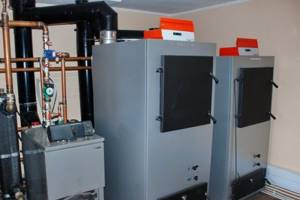
A wood-pellet boiler is selected according to power.
A thermal engineering calculation is required, which may seem complicated to a non-specialist.
You can estimate the required performance using a simplified formula:
W=0.1*S, where
W – device power, kW;
S – heated area, sq. m.
This dependence is valid for houses with the following parameters:
- ceiling height 2.5-2.7 m;
- standard sizes of window openings;
- thermal resistance of enclosing structures that meets the requirements of SNiP “Building Climatology” for the given region;
- the presence of double-glazed windows.
In case of abnormal cold weather, it is recommended to add a reserve of 15%-20%. For a 2-circuit boiler, add the same amount so that it is enough to heat the water.
The simplified method gives a large error in both directions; it is recommended not to save money and order a calculation from a heating engineer.
Popular models
The most famous suppliers of solid fuel units are the following brands:
- Lithuanian Stopuva;
- German Buderus;
- Czech Wattek;
- Belgian ACV;
- Austrian Wirbel;
- Russian NMK, Zota and TeploGarant LLC.
Among the models on the market from various companies, there are several popular devices.
Stropuva Mini S8
A power-independent unit serving an area of up to 80 square meters. m. Works with three types of fuel and is distinguished by its small size. Equipped with a convenient vertical firebox door.
The special design of the ash pan allows you to reduce the need to clean it to twice a month. One bookmark is enough for daily heating; the pellets burn out in 48 hours.
Advantages:
- high efficiency;
- quality of construction;
- safety;
- presence of a thermometer.
Flaws:
- heavy weight;
- The rough surface of the door makes it difficult to clean.
| Roman Oborin: | Igor Falaev: |
| “Economical and compact unit, burns for a long time. It consumes little fuel, heats the house well, and does not produce soot. The only negative is that it’s a bit heavy.” | “A small, convenient barrel, the device is immediately ready for use, you don’t need to assemble or screw anything in. The door handles are of high quality and reliable, they do not open spontaneously. It takes a long time to heat, it can burn for up to 20 hours.” |
Teplodar Cooper Expert-15
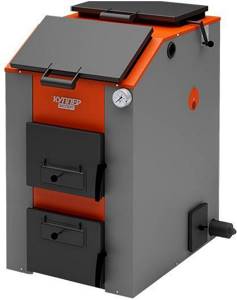
In the upper half of the housing there is a fitting for air outlet. Compatible with firewood, coal and briquettes. Three air entry zones and top combustion ensure long-term heat maintenance. At the bottom there is a water reservoir that prevents excessive heating of the floor. A steel plate protects the door from heat. You can additionally attach a draft regulator.
Advantages:
- possibility of installing a pellet or gas burner;
- convenient door placed at an angle;
- continuous burning for 24 hours.
Flaws:
- complexity of installation;
- small firebox.
| Oleg Egorin: | Semyon Ivin: |
| “It’s a convenient boiler, you can buy an additional burner, it works for a long time and even after switching off the house remains warm.” | “It’s not a bad unit, it’s enough for almost a day of heating, but it consumes a lot of fuel. Convenient door design for stowage." |
ZOTA Topol-16VK
A device with a water circuit at an affordable price. The triangular shape of the pipe avoids blockages and increases the service life of the device. To refuel the boiler, you can use firewood, coal and pellets.
The model is distinguished by a spacious firebox and the possibility of top and side fuel storage.
Advantages:
- low price;
- ease of use and cleaning;
- efficiency.
Flaws:
low efficiency.
| Vladimir Kharitonov: | Alexey Zaitsev: |
| “A high-quality device at an affordable price for its segment. Works flawlessly." | “The device is pleasant to use, cleans without problems, you can load different types of fuel, both briquette and regular.” |
Teplodar Cooper Expert-22

Combustion from top to bottom ensures uniform and longer combustion of the material and good heat transfer. The upper cleaning hatch is protected by a steel screen that prevents burning.
Advantages:
- two hatches for cleaning;
- inclined door for top loading;
- top burning function.
| Evgeny Zherdev: | Ivan Alaev: |
| “Sophisticated heating adjustment, you can adjust the burning duration from 30 minutes to a day. Easy to clean, special cleaning accessories included.” | “A high-quality model, the design allows you to connect heating pipes from either side. The device comes with a heating element and a thermomanometer.” |
Stropuva S30
Solid fuel boiler for placement in commercial and residential premises. Equally effective for year-round and seasonal use. It is characterized by high efficiency, is independent of power supply and is compatible with a variety of fuel materials.
The device has compact dimensions and is environmentally friendly. The duration of firewood burning is up to 30 hours, briquettes can smolder for up to 2 days.
Advantages:
- safety of use;
- high efficiency;
- durability;
- build quality.
Flaws:
high price.
What is a cubic meter
As the name suggests, a cubic meter or cubic meter (m3) is the volume of a cube whose sides measure one meter. This value is commonly used to measure gas, water, snow, sand and other bulk materials and liquids.
However, this value is only suitable for measuring a whole piece of wood, for example Pine: if you add a cube of individual firewood and boards, the distance between them will still be a few millimeters.
Therefore, when purchasing firewood, boards and other “non-purpose” parts, cubic meters will not fit: you will have to measure each block from all sides and try to enter it into the given parameters. This is too long and may lead to errors.
In order to simplify the recalculation process and reduce the likelihood of fraud, another term was introduced - a fallback measure.
The easiest way is to imagine a stack of wood measuring 1m x 1m x 1m x 1m x 1m x 1m x 1m, with the logs stacked and joined as close together as possible. There is still some distance between them - a small distance, but important when buying a large amount of firewood.
To convert the odometer to a cubic meter, you need to calculate the pipe size (length, height and width) and multiply it by the special coefficient shown in the following table. This will help you get the actual amount of firewood.
The value of the coefficient can be found in special tables and in photographs: They depend on the type of tree, the length of the trunk and its volume.
For deciduous trees
For conifers
In other words, the shorter the logs, the more space they can take up in a package, and round wood takes up more volume than cut wood.
The easiest way to find out the bearing dial value, for example, is as follows:
A stack of thin, 0.75 meter long birch wedges was purchased. The stack size was 1.5 meters * 3 meters * 2.5 meters. It is necessary to calculate the total amount of wood used using a calculator:
The volume of the stack itself must be calculated by multiplying its sides: 1.5 * 3 * 2.5 = 11.25 cubic meters; Then it is necessary to determine the coefficient of the wood species itself: Birch is 0.65; Both numbers are multiplied again: 11.25*0.65 = 7.3125 = specific gravity.
This is almost four cubic meters of difference. If not for the size of the odometer, the buyer would have to pay much more for the purchase.
Requirements for installation and operation of the boiler
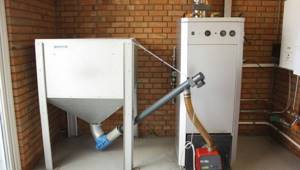
Heating equipment operating on compressed wood pellets requires certain rules for installation and operation.
Installation:
- Installation must be carried out on a flat and hard surface.
- The boiler room must be heated and equipped with ventilation.
- Installation of equipment must be carried out in accordance with all standards and requirements of the manufacturer and fire safety.
- The boiler room must be supplied with oxygen for the unit to operate;
Exploitation:
- It is necessary to select the correct type of wood pellets.
- Low or high room temperatures may be due to incorrect temperature settings of the equipment.
- Based on climatic conditions, it is necessary to select the right boiler for each individual region of the country. This way you will ensure maximum efficiency of your heating equipment;
Quick tips:
- When switching to this type of heating, take into account the fuel delivery conditions.
- Do not give preference to unknown brands and do not skimp on cheap models, this may affect the quality.
- Correctly calculate the volume of the bunker.
- Do not use pellets with high ash content.
Advantages and disadvantages
To get a complete understanding of the operation of solid fuel heating boilers, it is not enough to know their operating principle and design. To do this, you will need to familiarize yourself with the advantages and disadvantages. The positive aspects include the following characteristic features:
- increased efficiency, eliminating the need to create large reserves of firewood or coal;
- high efficiency, which can only be achieved when operating gas boiler equipment;
- high calorific value of the source material;
- the cost of solid fuel is quite low compared to the thermal effect;
- absolute safety of operation of this type of equipment;
- the ability to fully automate the workflow;
- the ability to control the state of the system without human intervention, since the built-in automation controls the fuel supply and temperature conditions of the system;
- durability and reliability of the equipment as a whole.
Units of this class have disadvantages that must be taken into account when choosing a specific sample of heating equipment:
- high cost of components produced specifically for do-it-yourself repair of units;
- difficulty in purchasing combustible fuel (pellets), due to the poor organization of the wood pellet production process;
- high energy consumption associated with additional electricity costs for process automation.
A peculiarity of the operation of the equipment is the need to re-adjust the heating system after it has been forced to stop for more than 10 hours. The difficulties of handling pellet boilers also include the user’s constant concern for the continuity of power supply from the current source. To avoid being affected by unexpected power outages, it is recommended to install an autonomous generator.
Types and design of heating systems with natural circulation
Each heating option without a pump consists of the following main elements:
A heat source, which can be represented in the form of a boiler with various types of fuel; Expansion tank used to stabilize the pressure in the system; Pipelines for coolant circulation; Radiators that heat living spaces.
Depending on the type of coolant, the natural circulation system is usually divided into the following two types:
Hot water preparation; Steam heating.
Let's take a closer look at all the features of these two types of household heating systems.
Ninth criterion - design
As they say, you meet by your clothes, you see off by your mind. Appearance and design matter when deciding to buy a pellet boiler in Krasnodar. But, in our opinion, these characteristics are of the least importance for such utilitarian heating equipment as a solid fuel boiler with automatic supply of pellet fuel.
Of course, if the chosen pellet boiler is economical, easy to use, inexpensive, and even beautiful, this is always impressive. However, unfortunately, in the market for this heating equipment, we have to select a boiler for the customer not according to its advantages, but according to the least disadvantages. And they can only be recognized by direct handling of the pellet boiler and during long-term operation.
Warmth to everyone, the ability to distinguish a specialist from an ignoramus who wants to make money on your problem, and the opportunity to do it right away with high quality, so that you don’t have to redo it later.
Stropuva S20P
4.3
In eighth place in the ranking is a product from the Lithuanian brand Stropuva. The model has a power of 20 kW and is suitable for heating a house area of up to 200 m². The unit operates according to a single-circuit circuit, but optionally an indirect heating boiler can be connected to the chimney. The pellet boiler operates with a programmer located on the left side of the body. To increase the draft, a fan operates at the outlet. It is allowed to burn both pellets and firewood in the firebox, and the length of the latter is allowed up to 45 cm, which is what the owners like in the reviews. To prevent accidental loss of heat from the firebox, the model is equipped with powerful locking handles.
We have added a pellet boiler to the rating as the most compact one. Although the unit is not small, due to its cylindrical shape it takes up little space on the floor, so it will fit into a boiler room with an area of 1.5 m². The manufacturer also offers seven body color options, from olive to red, which is convenient for choosing an interior if the boiler is installed in a kitchen or bathroom.
Advantages
- automatic release of excess pressure;
- simple connection to the heating circuit through a pipe with a diameter of 32 mm;
- autonomous combustion up to 31 hours;
- pressure gauge on the body.
Flaws
- designed for a system pressure of no more than 1.5 bar;
- there is no automatic pellet feed and hopper;
- weight 235 kg;
- heat exchanger made of steel.
Automation
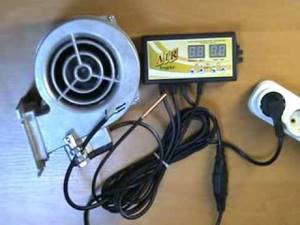
- compliance with the temperature regime in the system;
- control of pumps in the main and auxiliary (admixture circuit) circuits;
- maintaining the set temperature of hot water supply;
- control of coolant flows using a three-way valve.
If there is an automation unit, a person only needs to set the required temperature and load fuel, then the combustion process is controlled automatically according to the specified settings by controlling the supply of oxygen to the firebox. If heating is carried out using a pellet unit, then the fuel is loaded automatically.
Operating principle of three-way valve
If there is a three-way valve, the system works on the principle of mixing hot water from the boiler into the main flow when the temperature drops below the set one. This principle allows you to heat only the required amount of water. It can be supplied either directly from the boiler or from a buffer tank. At the same time, it can be heated by alternative sources, for example, a solar collector.
Basic installation rules
Connecting the heating element to a one-pipe system.
For a high-quality installation of a heater with natural coolant circulation, the following important steps must be taken:
It is preferable to place radiator heaters under windows at the same height. Install the boiler. Install the expansion tank. Connect the installed elements with pipes. Place coolant into the heating system and check all components for leaks. Fire up the boiler and enjoy the warmth of your home.
Important information from installers:
The boiler should be installed as low as possible. Pipes must be laid with a backward slope. It is recommended to avoid a large number of windings in the system. Use large diameter pipes.
We hope that we have covered all the nuances of a heating system without a pump that will help heat your home.
For information on installing a heating system without a pump, see the explanation of the gravity loop in the following video:
Page 4
Among the additional equipment in heating systems with liquid coolant, there are currently circulation pumps. They are used for heating all types of fuel.
In most cases, installing an additional pump in the natural circulation system significantly increases the speed of movement and heating of the room. The device itself does not have a particularly complex design and is small in size.
Particular attention should be paid to the parameters of the additional pump and system.
Principle of operation
The principle of operation of a solid fuel boiler occurs according to the following cycle of supply and combustion of pressed wood pellets:
- From the hopper, an external screw conveyor delivers pellets to the preliminary combustion chamber.
- Depending on the model of the unit, fuel from the pre-furnace reaches the grate or burner nozzle through an internal auger or free fall. With the help of auto-ignition, ignition occurs.
- The primary air flow is directed under the grate, fuel is purged and the grate (retort) is cooled.
- The secondary air flow is directed to the burner, into the combustion chamber, through air channels in the boiler body or directly in the burner itself.
- In economy class units, ash spills into the ash pan through the gaps between the grates. More expensive models, with advanced functions, are equipped with movable (tipping) grates for removing ash from the firebox.
- In cheap series boilers, the ash pan is cleaned manually. To do this, you need to stop the operation of the device after filling the ash collection container. In automated analogues, waste combustion products are removed using automation. Using an auger, the ash moves from the container along the ash channel to the external ash pan. As it progresses, it is compressed, which makes it possible to produce an external ash pan with minimal dimensions.
Important: for boilers without automation: when using good quality wood pellets, the ash pan is cleaned every 6 - 7 days; when burning agropellets, cleaning must be done every 3 days; using coal requires removing ash daily.
Pros and cons of this type of raw material
Pellets entered the market as a heating product relatively recently, but their popularity is already obvious. And although the prices for equipment that uses them as fuel are not cheap, due to their positive qualities they are becoming more and more popular for heating rooms. Thanks to the variety of their types, you can choose heating equipment according to your needs. If possible, you can choose a boiler with a combustion load for several hours, several days, and even months
In the modern world, more and more attention is paid to the environmental friendliness of the products used. And compressed wood waste becomes an alternative in this case. They are convenient to store; when supplied in bags, they are light and compact in placement
And their quantity is required less than other types of fuel
They are convenient to store; when supplied in bags, they are light and compact in placement. And their quantity is required less than other types of fuel
It is also important that when they burn, the smoke has no odor
The disadvantage of using them, which cannot be avoided, of course, is the release of ash. And even when using elite brands of wood pellets, it is necessary to clean the boiler at least once every two months. And after the winter season, be sure to completely disassemble and clean the boiler. The storage location is also important. And for better performance of their properties, they should be stored in dry rooms without the possibility of getting damp. Since raw ones can cause the boiler to stop working.
Advantages of pellet equipment
Today, the advantages of boilers running on pellets are significant, which makes them in demand. One of the most important advantages is high efficiency, it reaches 80-97%. It is comparable to the most recognized heating equipment - gas boilers.
It is important that efficiency is ensured by cheap fuel - pellets are made from wood waste (shavings, pressed sawdust of various hardwoods or softwoods), thanks to which their cost is second only to gas. Moderate fuel prices coupled with high efficiency ensure the equipment is economical
In Russia, this is the cheapest type of heating after gas; in a number of post-Soviet countries (for example, Ukraine) it is even the most affordable
Moderate fuel prices coupled with high efficiency ensure the equipment is economical. In Russia, this is the cheapest type of heating after gas; in a number of post-Soviet countries (for example, Ukraine) it is even the most affordable.
For example, using a pellet boiler will cost 1.5 times less than similar equipment running on coal. And heating a building with an electric boiler is 2-3 times more expensive.

A pellet boiler differs from any other solid fuel boiler only in the presence of a special burner
An important advantage is autonomy in operation - it is achieved by a high level of automation. For example, the boiler itself is capable of supplying the required amount of pellets into the firebox, controlling the temperature regime set by the owner, and stopping and starting operation. Often the equipment is even able to clean itself of ash.
Autonomy ranges from 2-15 days, and if the automated boiler is provided with an uninterrupted supply of fuel, it can operate without human intervention throughout the cold season. Also, these units are independent of the presence of centralized heating and main gas pipelines.
We must not forget about environmental friendliness - pellets are compressed sawdust, they do not contain glue or other binders. This guarantees the absence of harmful substances (for example, sulfur) in the granules; their ash content is tens of times lower than that of firewood, as is the emission of carbon dioxide.
Another important advantage is safety. To ensure this, a multi-level fire protection system is used, which includes control sensors, electronics that interrupt the supply of pellets, automatic shutdown, a number of boilers are equipped with alarm systems
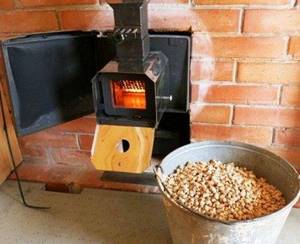
You will also be pleased with the cheap service - this is a guaranteed fact, explained by the fact that there is little work and any person who does not have special skills can cope with them
An important advantage is the simple installation - the boiler owner does not need to obtain any permission or draw up a project. Current rules allow the installation of such equipment in utility rooms, basements, corridors, and kitchens. In addition, you can do the piping of a pellet boiler yourself.
How is such equipment connected?
The general installation scheme of heating boilers consists of the following series of stages:
- installation of distribution combs;
- installation of appropriate pumping circuits for each consumer;
- installation of safety equipment;
- installation of an expansion tank;
- installation of shut-off valves;
- connection of the boiler with the supply and return circuits;
- filling the circuits with coolant;
- testing equipment and checking its operation.
In practice, everything depends on the power of the equipment, the number of consumers, the design features of the boiler, etc. It should be noted that quite high requirements are placed on the piping of pellet boilers. Firstly, because the moisture content of the fuel must remain acceptably low, and secondly, because both the fuel and the coolant are heated to very high temperatures. Poor-quality piping can lead to the fact that the operating conditions of the equipment will be violated, and the boiler will quickly fail.
In accordance with fire safety standards, it is recommended to use non-flammable metal pipelines for piping pellet boilers. The use of polypropylene structures in practice is not only dangerous, but also unprofitable, since the temperature of the coolant at the boiler outlet often exceeds the performance indicators of polymer materials. As a result, the pipelines will have to be replaced within a couple of years.
A pellet boiler is a rather complex device. Experts strongly do not recommend that inexperienced beginners install and wire such devices. However, knowledge of the main stages of tying and some of the nuances of this process will allow you to effectively monitor the work of the invited team of installers.
The diagram shows one of the options for piping a pellet heating boiler: 1 - MK pump; 2 - mixing valve MK; 3 — pump TK1; 4 — mixing valve TK1; 5 - water recirculation in TK1; 6 — pump TK2; 7 — mixing valve TK2; 8 — water recirculation in TK2; 9 - DHW pump; 10 - DHW heat exchanger; 11 - supply of running water to the hot water supply
To piping a pellet boiler, you must:
- install the boiler;
- connect the appropriate burner (if a combined boiler model is used);
- install a pellet hopper;
- connect the auger for fuel supply;
- connect the automatic boiler control panel.
After this you should do:
- Installation of a safety group on the boiler supply, which includes a pressure gauge, automatic air vent and relief valve.
- Installation of a thermal valve sensor, if provided for by the design of the model;
- Installation of a chimney whose diameter and height meet the technical requirements.
- Installation of a system of devices to maintain reverse flow: two pressure gauges for supply and return, a circulation pump and a thermal head.
- If there is a high probability of sudden power outages, it is recommended to supplement the system with a suitable UPS model.
Reverse flow support allows you to control the heating level of the coolant before it enters the system. Until the return temperature reaches the required level (usually 60 degrees and above), the coolant will remain within the small circulation circle. Only when the coolant is heated to the required level will the thermal head open and cold coolant begins to flow through it, and hot coolant will begin to circulate in the main circle.
Under no circumstances should you use a pellet boiler with a low coolant temperature. A temperature of 55 degrees is the so-called “dew point”, upon reaching which a significant amount of condensation occurs. As a result, the volume of soot in the chimney, as well as on the heat exchanger, can increase significantly. The equipment will require additional maintenance efforts, and its power will noticeably decrease.
This is what the combustion chamber of a pellet heating boiler looks like after exposure to excessive amounts of condensate that appears due to errors in the installation of the recirculation system
The process of piping a combined pellet boiler is presented in detail in the video:
Many manufacturers of pellet boilers recommend supplementing the design with a special storage tank, which allows you to accumulate heat. Fuel savings can reach 20-30%. In addition, the use of a storage tank allows you to avoid overheating of the boiler and achieve the highest possible efficiency.
Some information about pellets. What it is?
Pellets are cylindrical granules measuring 5-7 cm, made from wood waste. The diameter of such a granule is slightly more than 6-8 mm. The size of the granules is influenced by the quality of the raw materials used and the production method.
Under pressure, wood raw materials are compressed, thereby achieving a high density of the substance. Granules, unlike wood, sink in water. During the manufacturing process, the required humidity of the composition is achieved, no more than 10%. Such strict parameters for the finished product are caused by the desire to achieve maximum results in the combustion process. Long-burning boilers and pyrolysis-type units readily use pellets as the main type of fuel.
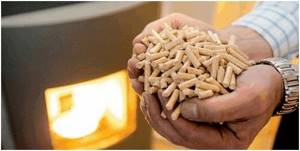
Less often, waste from furniture production is taken for production, where expensive types of wood are more often used. Such pellets burn better and longer. The only negative that is obvious in this case is the high price of such fuel.
Today, waste from the main products of agriculture and the food industry is actively used to make fuel pellets. Husks from sunflower seeds and remains of corn cobs are excellent raw materials for combustion.
The main advantage that pellets have is complete combustion in the furnace of boiler equipment. This type of fuel has a high calorific value, which is similar to burning coal. If it is possible to use pellets constantly, why not take advantage of it. Whether to give preference to a pellet unit or a solid fuel boiler in a classic design, choose the first option.
Making an economical device with your own hands
The pellet boiler has a fairly simple structure, so it is not difficult to assemble it with your own hands. To do this you will need steel pipes or sheets 3-5 millimeters thick, a grinder and a welding machine. If you have never had to deal with welding work before, contact a professional.
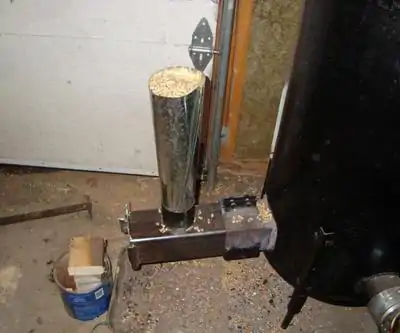
The main element of the boiler is the heat exchanger. It is better to make it in a rectangular shape from pipes with a square cross-section. For this:
- Pipes of the same size are taken.
- A round window is made in the vertical rack.
- Holes are cut in the front pipes for drainage (one for cold water, the other for hot water).
- The structural parts are connected using a welding machine.
To ensure even seams, the racks are best placed on a flat surface.
Before carrying out installation work, the device is checked for strength:
- the apparatus is placed vertically;
- close the lower hole;
- pour water into the container.
Attention! The design should not allow liquid to pass through even in small quantities. Otherwise, welding work will need to be done again.
After the boiler has been assembled and checked, installation begins. There are simple rules for installing this device:
The boiler should be installed in a non-residential area, for example, in a basement. It is worth taking care of the floor covering in advance
It is important that the floor is concrete or made of ceramic tiles. The room must be well ventilated
In the room with the boiler, air humidity and temperature are monitored. The boiler room should not be small in size, as it will be inconvenient to carry out maintenance work in it.
Constructive
Convective part
Design of the Teplodar Cooper OK 20 model for heating a private house with an area of up to 200 m².
First of all, when choosing a boiler, you should pay attention to its convective part, i.e. its heat exchanger
Heat exchangers in pellet boilers are often made of cast iron and steel. Cast iron heat exchangers are more reliable, but are inferior in price to steel ones, which have also proven themselves quite well. Gas channels in such a heat exchanger can be of two types: horizontal and vertical. Here the advantage of a heat exchanger with vertical channels is obvious, since, when burned, the pellet forms a certain amount of ash, which settles much more easily on the horizontal sections of the gas channels. As a result, the efficiency of fuel combustion decreases and heat transfer deteriorates. This type of boiler needs to be cleaned much more often.
A boiler with a vertical convective part is less susceptible to clogging. Manufacturers also often use technology that is firmly established in gas boilers - turbulators. These are inserts into the gas channels of the heat exchanger, designed to improve heat transfer in the convective part. However, the positive effect of turbulators is observed in the first time after cleaning. In practice, such a boiler becomes clogged quite quickly. In the worst case, the turbulators simply grow into the heat exchanger. In solid fuel boilers, it is much more effective to increase the total area of the heat exchanger, without compromising the permeability of the gas channels.
Important! The installation of turbulators by manufacturers is an attempt to reduce the cost of the boiler. Purchasing such a seemingly cheaper copy may result in unforeseen expenses in the future.
Fire safety
Attention should be paid to the fire safety of the pellet boiler and to the presence in its design of a fire protection system in the auger cavity and bunker. The simplest version of such a system is a tank of water sealed with a paraffin insert.
When the temperature in the screw cavity rises, the paraffin melts, freeing the passage of water and filling the ignited pellet. The method is simple but effective. Electronic protection and warning systems are also used.
Heat exchanger overheat protection
Do not forget that solid fuel boilers, unlike gas boilers, have a higher inertia. This means that even after the boiler has stopped, it continues to heat up for some time. Therefore, such a boiler must necessarily have protection against overheating, or even better, a forced cooling system.
Model ZOTA “Pellet”-15A produced by Krasnoyarskenergokomplekt.
Automatic ignition
This feature will save you from having to manually start the pellet boiler. This is especially convenient for low-power boilers that do not operate constantly or provide hot water supply needs.
Ash removal
Boiler maintenance
It is worth paying attention to the ease of removing ash from the boiler, as well as the presence of devices for cleaning the heat exchanger included with the boiler. These operations will have to be performed quite often
Note! Manufacturers of modern pellet boilers offer many interesting design solutions, so the above list is far from complete. In this article, we tried to focus on ease of use and safety.
Fuel
Before you decide to install a pellet boiler, it is worth assessing the availability of this type of fuel in your region. It is advisable that the pellet manufacturer be local. This will save on delivery costs and also make it possible to purchase smaller quantities of pellets. The most acceptable option is when there are several manufacturers (suppliers) in the region who provide continuous regular supplies. This will protect you in case of equipment breakdown at the manufacturer and other unforeseen situations.
Fuel pellet production line.
Important! It is worth considering the place where you will store pellet supplies. It must be a dry place
During long-term storage, it is advisable that the pellet be packed in airtight packaging, since it tends to draw moisture from the atmosphere.
If pellets with a high percentage of ash content will be used, an option for ash disposal should be provided.
Comparison with similar devices
The cost of electricity, as well as gas, is constantly growing, which means that pellet stoves are profitable to buy, first of all, from the point of view of benefits.
Since they are completely independent of external sources, the system’s dependence on suppliers automatically disappears - the home owner himself decides how much pellets he needs to purchase, for example, for one winter season.
Main differences
The main difference between fireplaces using wood pellets and stoves using dry wood is that they do not emit carbon dioxide. When wood burns, it releases carbon dioxide, and this is very dangerous for the health of the inhabitants of a country house. The ash that is formed after the combustion of pellets can be used as fertilizer on the site or in the greenhouse.
Another distinctive feature of such devices is that they can be installed in homes when there is no gas pipeline nearby or the possibility of heating using an electric unit. Moreover, even if both gas and electricity are available, if they are turned off, the pellet stove will be a backup system for heating the cottage. This is especially true in extreme cold. With proper operation of such furnaces and timely maintenance work, they can last more than 20 years.
Institutional use
The popularity of installing pellet stoves in restaurants, shopping centers, industrial premises, hotels and social institutions (hospitals, schools, kindergartens) is understandable.
The fact is that compared to gas heating, heating rooms with pellets is approximately 2 times cheaper, and if we talk about electric heating, the economic benefits can increase by 3-4 times.
